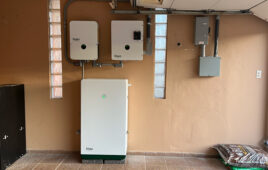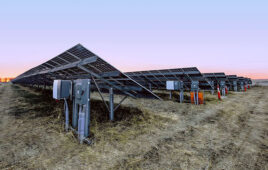The Solar Energy Industries Association (SEIA) has issued countermeasures for a change to the 2024 International Building Code that could increase the costs and inspection requirements of ground-mounted solar projects.
FEMA has proposed raising the risk category for ground-mounted solar from risk category I — which includes buildings that represent a “low hazard to human life in the event of failure,” like storage facilities and agricultural buildings — to category IV, which are “designated as essential facilities and buildings where loss of function represents a substantial hazard to occupants or users,” according to the IBC. Among the structures in category IV are first responder facilities, public utilities and power-generating stations, which would include PV solar.
SEIA argues that the leap in risk categories could increase the material makeup of solar racking and modules necessary to meet that level of inspection criteria, thus driving up manufacturing and project costs. FEMA’s proposal comes shortly after the passage of the Inflation Reduction Act, federal legislation that includes long-sought renewals for solar investment tax credits and new production tax credits meant to bolster domestic manufacturing.
“This is a gross overreach,” wrote Abby Hopper, CEO and president of SEIA, in a blog post. “There is no extended record of irreparable damage to solar arrays from higher seismic, wind or snow loads, and there is no justification for these overly burdensome codes.
“In practice, this code change will make most solar and storage projects too costly to build, which will weaken the grid and stop clean energy development in its tracks — all without any benefits to reliable electric service,” she continued.
SEIA’s rebuttal to FEMA’s proposal (IBC S76-22) requests that solar photovoltaic facilities are instead placed in risk category II (S79-22 and S81-22), which is composed of other low-risk structures. The organization argues that solar arrays pose little risk to people and continue to produce power through high weather events and natural disasters. Roth Capital Partners estimates that a shift to category II could increase solar tracker prices by 2-5%, category III by 10% and category IV by 30-40%.
SEIA is addressing a letter to the International Council Code calling for the rejection of S76-22 and approval of S79-22 and S81-22.





So why aren’t they simply referencing NESC which states that Solar is a generating station therefore it is to be built to Risk Category III?
Solar has so many over the top restriction and requirement that are not necessary! Grounding requirements are so ridiculous. Worries about a wire that some day might become bare and cause a shock!
Really, are we that paranoid. If so carry an ohm meter!
Should we care more about the air we breath and the oil contamination in our water!
The amount of money spent on over the grounding requirements could be used for health care!
Also all the requirements for solar when fire fighters on roofs with solar! How many fires start in a building in middle of the day requiring a fire fighter to get on the roof? That is such a unrealistic situation. People get trapped in houses at night when an unexpected fire break out, not in the middle of the day!
Utility companies do all they can to no to loose business.
Electrician union don’t want a labor person attaching a panels to a rail. I see no wiring issues in letting a common labor person attaching a panel to a rail. I think that electricians should stick to wiring not bolting panels down.
Would love to see how we can make more happen for the good of clean energy- easy and simple- not a process that has so much bureaucracy and worried about hypothetical situations. What if we all just stay in bed and think of reasons we could die if we step outside. That is government’s goal!
Grounding rules are to protect the equipment from induced lightning miles away.
Grounding is not to protect people but equipment.
While the industry continues to treat solar installations like placing cows in pasture the effects of wind are potentially great. When structures are limited to a couple of strands of wire being the only separation of the solar farm from the wind damage it is just a matter of chance and time. The sacrifice of some property for windbreaks and disruption of wind are valuable real estate the overall can result in more reliable planning.
““This is a gross overreach,” wrote Abby Hopper, CEO and president of SEIA, in a blog post. “There is no extended record of irreparable damage to solar arrays from higher seismic, wind or snow loads, and there is no justification for these overly burdensome codes.””
Some of this ‘hardening’ of solar PV installations has already been taken care of over the years with new mounting systems being developed over the last 10 years. Australia has had some substantial wind driven utility scale events where fixed ground mount arrays were ripped from the racking and others who used tracking had arrays damaged and solar PV panels twisted into a helix. The companies involved with these fails for the most part re-engineered and added superior metallurgy to their products to remediate wind loading and panel mounting failures. Things like using new design posts that actually screw into the ground for ground racking seems to work better in areas that get snow loads and the ground texture changes between freeze and thaw cycles.